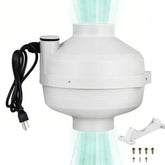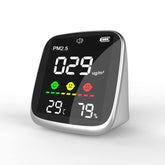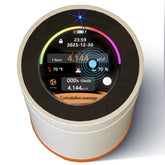What is Radon Gas?
Radon gas is a silent, invisible threat that could be lurking in your home right now. You can’t see it, smell it, or taste it, but it’s the second leading cause of lung cancer in the United States. Understanding what radon gas is, how it affects your health, and what you can do to protect your family is crucial. In this blog, we’ll break down everything you need to know about radon gas in simple terms, from its origins to how to test for it and reduce its levels in your home.
I. Introduction
A. Definition of Radon Gas
Radon is a radioactive gas that forms naturally from the decay of uranium in soil, rock, and water. It’s colorless, odorless, and tasteless, making it impossible to detect without proper testing.
B. Importance of Understanding Radon
Radon is a serious health hazard, yet many people are unaware of its presence in their homes. Learning about radon is the first step toward protecting your family from its harmful effects.
C. Overview of Radon’s Impact on Health
Long-term exposure to high levels of radon can lead to lung cancer, especially for smokers and those with pre-existing respiratory conditions. Testing and mitigation are essential to ensure a safe living environment.
II. What is Radon Gas?
A. Chemical Properties
-
Colorless, Odorless, and Tasteless: Radon is undetectable by human senses, which is why testing is so important.
-
Radioactive Noble Gas: Radon is a byproduct of uranium decay and emits harmful radiation.
B. Natural Occurrence
-
Formation from Uranium Decay: Uranium, found in soil and rock, breaks down over time and releases radon gas.
-
Presence in Soil, Rock, and Water: Radon can seep into homes through the ground or dissolve in groundwater.
C. How Radon Enters Homes
-
Cracks in Foundations: Radon can enter through gaps in your home’s foundation.
-
Gaps Around Pipes and Drains: Small openings around utility lines are common entry points.
-
Well Water: Radon dissolved in water can be released into the air when water is used for showering or cooking.
III. Health Risks of Radon Exposure
A. Link to Lung Cancer
-
Second Leading Cause of Lung Cancer: Radon is responsible for about 21,000 lung cancer deaths annually in the U.S.
-
Risk Increases with Long-Term Exposure: The longer you’re exposed to high radon levels, the greater the risk.
B. Symptoms of Radon Exposure
-
Often Asymptomatic Until Cancer Develops: Radon exposure doesn’t cause immediate symptoms, making it a silent threat.
-
Importance of Testing for Early Detection: Regular testing is the only way to know if your home has dangerous radon levels.
C. Vulnerable Populations
-
Smokers at Higher Risk: Smokers exposed to radon have a significantly higher risk of lung cancer.
-
Children and Elderly: These groups may be more susceptible to the effects of radon due to weaker immune systems.
IV. How to Detect Radon Gas
A. Radon Testing Methods
-
Short-Term Tests: These tests, like charcoal canisters, measure radon levels for 2-7 days.
-
Long-Term Tests: Alpha-track detectors measure radon levels for 90 days to a year, providing a more accurate average.
B. DIY Testing Kits
-
Availability and Cost: Radon test kits are affordable and widely available online or at hardware stores.
-
How to Use Them: Follow the instructions carefully, typically placing the kit in the lowest livable area of your home.
C. Professional Radon Testing
-
When to Hire a Professional: If DIY tests show high levels or you’re buying/selling a home, hire a certified radon tester.
-
What to Expect During Testing: Professionals use advanced equipment to provide precise readings.
V. Radon Levels and Safety Standards
A. Understanding Radon Measurements
-
Measured in Picocuries per Liter (pCi/L): This unit measures the concentration of radon in the air.
-
EPA Action Level (4 pCi/L): The Environmental Protection Agency recommends mitigation if levels exceed 4 pCi/L.
B. Interpreting Test Results
-
Safe vs. Unsafe Levels: Levels below 2 pCi/L are considered safe, while levels above 4 pCi/L require action.
-
Steps to Take if Levels Are High: Contact a radon mitigation professional to install a reduction system.
VI. How to Reduce Radon Levels
A. Radon Mitigation Systems
-
Sub-Slab Depressurization: A common method that uses pipes and fans to vent radon from beneath your home.
-
Drain Tile Suction: Similar to sub-slab depressurization but uses existing drainage systems.
B. Sealing Cracks and Openings
-
Foundation Cracks: Seal gaps in your foundation to prevent radon entry.
-
Gaps Around Pipes: Use caulk or foam to seal openings around utility lines.
C. Improving Ventilation
-
Installing Ventilation Fans: Increase airflow to dilute radon concentrations.
-
Opening Windows Regularly: Allow fresh air to circulate, especially in basements.
VII. Radon in Water
A. How Radon Enters Water Supplies
-
Groundwater Sources: Radon can dissolve in well water from underground sources.
-
Risks of Inhaling Radon from Water: Showering or washing dishes can release radon into the air.
B. Testing Water for Radon
-
Methods for Testing: Use a water radon test kit or hire a professional.
-
Interpreting Results: Levels above 4,000 pCi/L in water require mitigation.
C. Mitigating Radon in Water
-
Aeration Systems: These systems remove radon by bubbling air through the water.
-
Granular Activated Carbon Filters: These filters absorb radon but require proper disposal to avoid radiation buildup.
VIII. Preventive Measures
A. Regular Radon Testing
-
Testing Every 2-5 Years: Radon levels can change over time, so regular testing is essential.
-
After Home Renovations: Structural changes can affect radon entry points.
B. Building Radon-Resistant Homes
-
Features of Radon-Resistant Construction: Include vapor barriers and vent pipes during construction.
-
Benefits for New Homebuyers: Radon-resistant homes are safer and more marketable.
C. Educating Homeowners
-
Awareness Campaigns: Spread the word about radon risks and testing.
-
Resources for Further Information: Check the EPA website for guides and tools.
IX. Conclusion
Radon gas is a hidden danger that can have serious health consequences, but it’s also a problem you can solve. By testing your home, understanding radon levels, and taking steps to reduce exposure, you can protect your family from this invisible threat. Don’t wait—take action today to ensure your home is safe and radon-free.
X. Additional Resources
-
Links to Radon Testing Kits and Services: Radon Testing kit
-
EPA Guidelines on Radon: EPA Radon Guide
-
Further Reading on Radon and Indoor Air Quality: CDC Radon Information
By following this guide, you can take control of radon gas in your home and create a healthier living environment for you and your loved ones









Leave a comment
All blog comments are checked prior to publishing